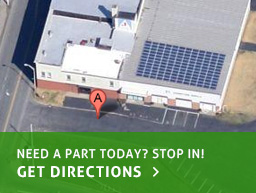It's a new technology for storing energy, an important part of enabling more wind and solar power on the grid. It's from a company called ARES. Here's how it works:
- The train carries big rocks uphill, consuming electricity.
- Then the train carries big rocks downhill, generating electricity.
That's it. The energy stored by going uphill is released by going downhill.
Pretty neat. The details are fun too — it's a clever, low-tech solution to some important high-tech problems.
Using gravity to store energy
Say the grid temporarily has more renewable energy than it needs — the wind is blowing, the sun is shining, and there's not enough demand to make use of it.
Advanced rail energy storage (thus "ARES") can absorb that excess energy, using it to power electric trains that pull giant slabs of concrete up a gentle slope. In effect, the trains convert the excess electricity to potential energy.
/cdn0.vox-cdn.com/uploads/chorus_asset/file/6400205/energie-dk-grid2.gif) (ARES)
(ARES)
When the grid needs that energy, the same rail cars carry the giant slabs downhill, converting the potential energy back into electricity. (Thanks, gravity!)
The conversions are done by an electric motor. When it goes uphill, it consumes electricity. When it goes downhill, it runs in reverse, generating electricity (similar to how "regenerative braking" works in cars).
The company claims the process, end to end, is 86 percent efficient, i.e., 86 percent of the energy that's put into storage can be gotten back out. It hopes to improve that number as it dials in the technology.
ARES provides more than storage
ARES already has a test track in the Tehachapi, California, region, but earlier this month, itgot approval from the Bureau of Land Management for its first commercial-scale project.
That project, called ARES Nevada, will consist in a 5.5-mile track traveling up an 8-degree slope, covering 106 acres of public land near the delightfully named town of Pahrump, Nevada. It will boast 50 MW of power capacity and be capable of producing 12.5 MWh of energy. The company expects to start construction early next year and finish by 2019.
Here's the thing: This first project won't provide energy storage.
ARES says it can build three different kinds of projects.
The smaller ones (20-50 MW), like the one being built near Pahrump, will provide"ancillary services" to the grid — in this case, the California grid.
Ancillary services can get pretty technical (VAR support! grid inertia!), but the simple explanation is that the ARES system can ramp up and down quickly, smoothing out fluctuations in power supply on the grid. That's worth money.
Medium-sized ARES projects (50-200 MW) will provide both ancillary services and short-term storage, roughly two hours' worth. While the former smooths out minute-by-minute variations in wind and solar, the latter can smooth out longer (hourly) fluctuations.
The large ("grid scale") ARES projects could range from 200 MW to 3 GW, which is a hell of a lot of storage — enough, the company says, to provide four to 16 hours of power at full output. At that point, a project starts looking less like a way of smoothing out fluctuations and more like a full-fledged power plant of its own, capable of backing up an enormous amount of renewable energy.
The benefits of rail storage
Rail storage has a lot to recommend it.
For one thing, though ARES is the first company to apply it to the task of energy storage, rail itself is an extremely well-understood technology. Almost everything ARES uses is off-the-shelf — no experimental tech or breakthroughs required. That substantially reduces investment risk.
Rail also compares favorably to other forms of energy storage.
ARES systems do not respond quite as fast as batteries (five to 10 seconds, as opposed to effectively instant), but the company claims its capital costs are far lower. Also, rail cars and concrete slabs, unlike batteries, do not degrade over time.
And rail storage is faster, with lower capital costs, than its main rival in grid-scale storage, pumped hydro (which pushes water up and downhill just like ARES pushes slabs). It's also more scalable than pumped hydro — you can do it incrementally all the way from 20 MW to 3 GW — and can be located in more places. All it needs is some open land and a slope. Notably, it doesn't need water, which allows it to operate in the arid American West.
/cdn0.vox-cdn.com/uploads/chorus_asset/file/6402737/ares-energy-storage-rail-car.jpg) (ARES)Carrying a slab through the desert.
(ARES)Carrying a slab through the desert.
Finally, rail storage has a relatively small environmental footprint. CEO Jim Kelly has saidthat rail storage "produces no emissions, burns no fuel, requires no water, does not use environmentally troublesome materials, and sits very lightly on the land." He told trade mag SNL:
When you're done and it's time to decommission, you repurpose the railcars, you recycle the rails, you recycle the railroad ties, you rake up the gravel, you throw down grass seed," he said. "In a year no one knows you were there.
Challenges facing rail storage
There are few easy roads in the energy world. ARES will have to build its project in Nevada and prove that it can perform as promised, of course. And the bigger projects are still a question mark. Ancillary services are one thing, arbitrage — buying power when it's cheap, selling it back to the grid when its more valuable — is another. (UtilityDive has anice piece on ARES that delves into the financial challenges, among other things. See also ClimateWire and SNL.)
The vagaries of energy markets, especially in the fast-developing area of energy storage, make it unwise to predict success for any particular technology or company.
Still, rail storage has an appealing low-tech simplicity. It's not some breakthrough in a lab, it's just a clever way of repurposing existing materials. The train goes up. The train goes down. It's so easy to explain.









